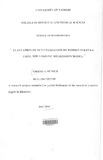| dc.description.abstract | HIV/AIDS pandemic is a global crisis with consequences that will be felt for decades to
come. It has already claimed more than 25 million lives and another 40 million people are
currently estimated to be living with HIV/AIDS worldwide. Women account for half of the
people living with HIV/AIDS worldwide and nearly 60% of HIV infections in Sub-Saharan
Africa. VeT has been described as a high-leverage intervention for HIV/AIDS prevention in
sub-Saharan Africa because of its demonstrated effectiveness. This is, however, restricted to
few areas making it inaccessible to various individuals who may want to be tested. This study
sought to establish the trend in uptake of VCT and establish factors associated with the
utilization of VCT Data was extracted from KDHS data collected for the years 2003 and
2008. Using SPSS version 15.0 and 17.0, several variables were cross tabulated against the
constant variable ever been tested for HIV and Chi square used to detect differences in
categorical variables between or among groups. To test if there was a significant difference in
the two years, the t value of the proportions was calculated and compared with the t tab.
Logistic regression analysis with stepwise elimination was used to determine factors that had
statistical significant association with the outcome ever been tested. Factors included in the
analysis were age, marital status, wealth index, region, residence, highest education level,
religion, currently/formerly/never married, number of unions, husband lives in house, ever
been married and number of other wives. The outcome of this study revealed a significant
association between VCT utilization and various factors. These included age, marital status,
wealth index, residence, region, religion, highest education level and husband lives in house.
VCT uptake was greater in 2008 compared to 2003. | en |

